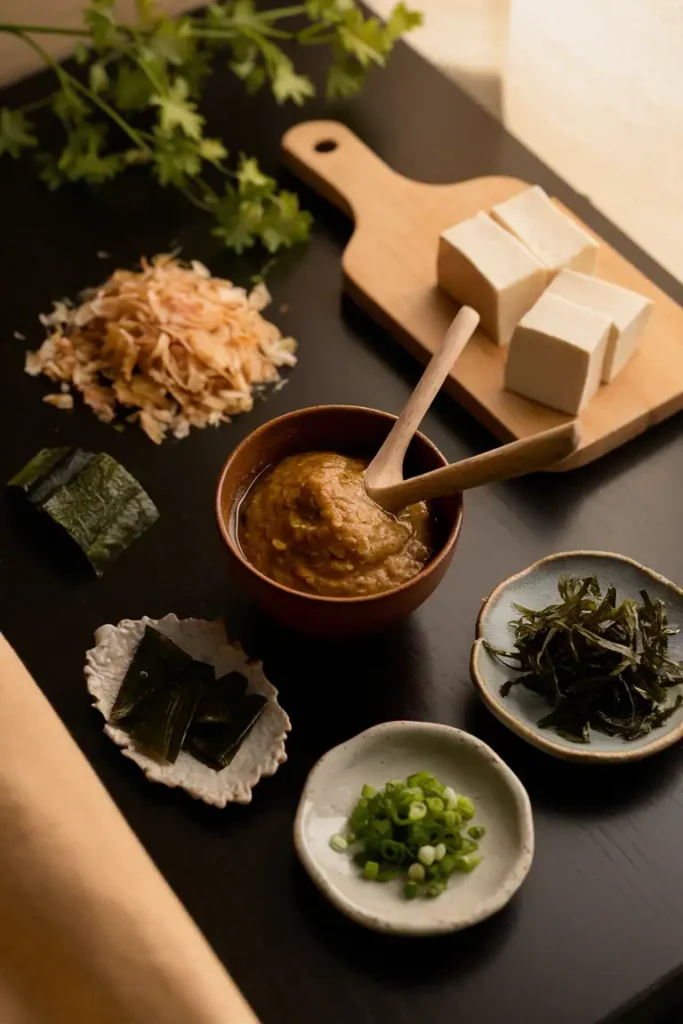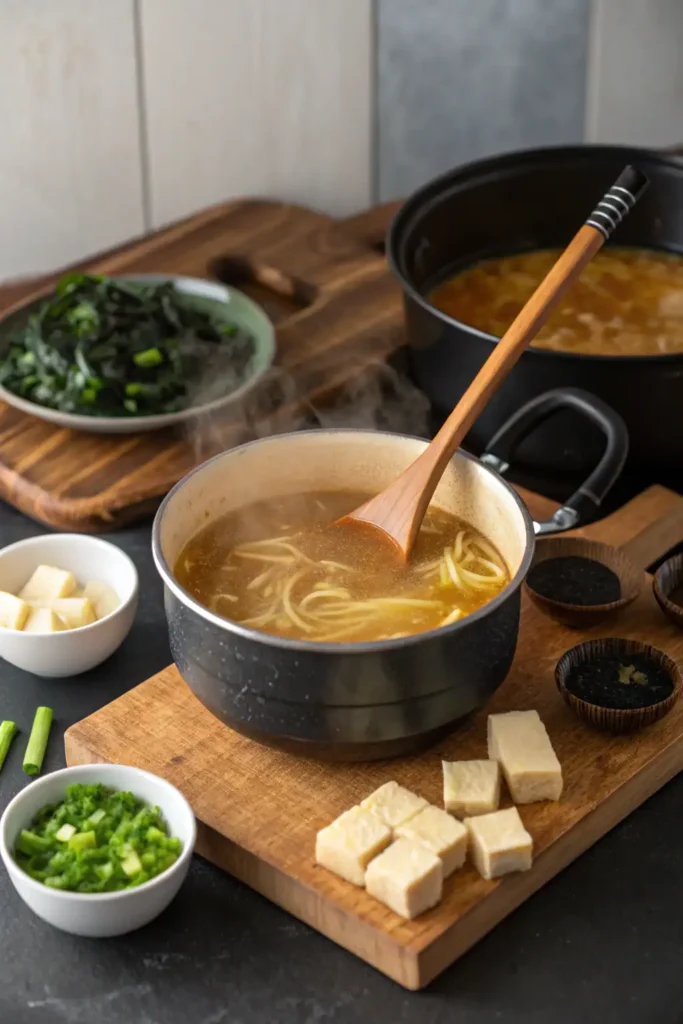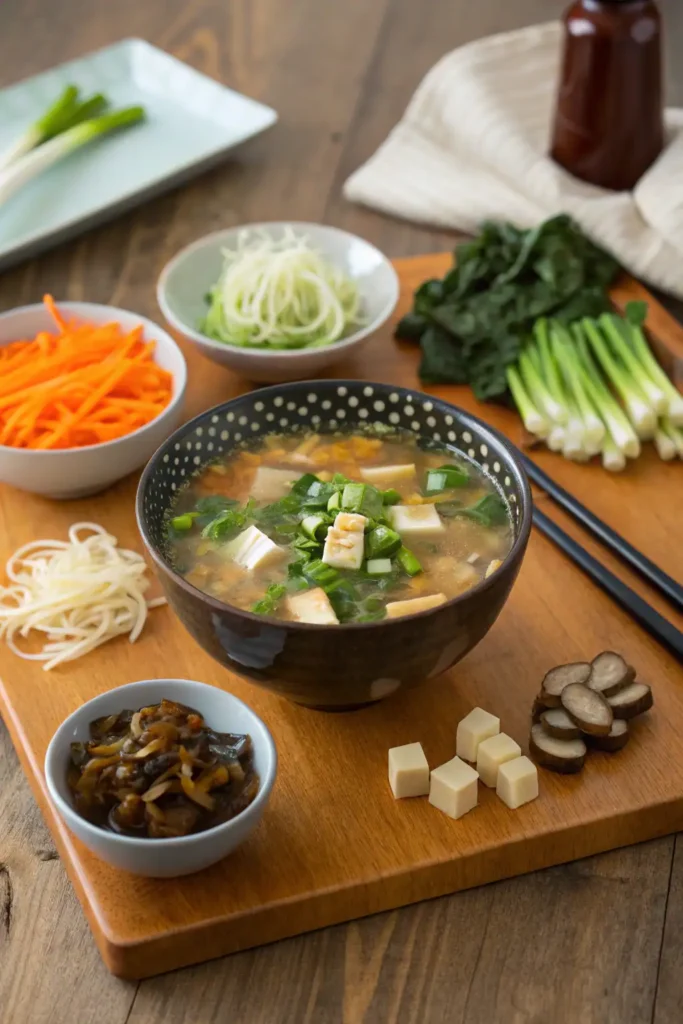Prepare Miso Soup in 15 – Minutes
Want to make authentic miso soup? This Japanese dish is simple yet full of flavor. Learn the best miso types and add-ins for a perfect bowl.
JUMP TO RECIPE

What Is Miso Soup?
Miso soup is a warm and comforting dish that holds a special place in Japanese cuisine. This simple yet flavorful soup is made with a few key ingredients that come together beautifully. To make miso soup, start with dashi, a Japanese soup stock that adds depth and umami flavor, and then mix in miso paste, tofu, and green onions for a satisfying meal.
With its roots in Japan, miso soup is not just a food item but also an essential part of the Japanese diet. It can be easily customized with various ingredients, making it perfect for different tastes and dietary needs. Whether one prefers a classic version or a unique twist, making miso soup at home is a rewarding experience.
Once you gather the essential ingredients, it’s easy to prepare this delicious dish. Readers will find that making miso soup takes no time and can become a staple in their kitchens, providing warmth and nourishment in every bowl.
Key Takeaways
- Miso soup utilizes dashi stock for a rich flavor.
- It can be customized with various ingredients for different tastes.
- This soup is a nutritious option that fits well in a healthy diet.
Understanding the Essentials
Miso soup has deep roots in Japanese cuisine and relies on a few key ingredients. Each element contributes to its unique flavor and nutritional value.
History of Miso Soup
Miso soup dates back to ancient Japan, with origins traced to the 7th century. It was initially a dish for the wealthy, as miso paste was expensive and made from fermented soybeans. Over time, miso soup became a staple in Japanese households.
This soup reflects seasonal ingredients and regional variations. Each area of Japan may incorporate local vegetables or seafood. The story of miso soup is tied closely to Japanese culture, emphasizing balance and harmony in meals.
What Are Key Ingredients For Miso Soup?
The essential ingredients of miso soup include:
- Miso Paste: This fermented soybean paste is the heart of the soup, providing a rich, umami flavor. There are various types, like white, yellow, and red miso, each offering distinct tastes.
- Dashi: This is a fundamental broth in Japanese cooking. Dashi is often made from kombu (seaweed) and bonito flakes. Its savory taste enhances the soup’s depth.
- Tofu: Soft or firm tofu is added for protein. It absorbs flavors well and adds a creamy texture.
- Seaweed: Wakame is commonly used. It rehydrates in the soup, adding a slight ocean taste and extra nutrients.
Together, these ingredients create a comforting and nourishing bowl of miso soup, making it a beloved dish in Japan and beyond.
How To Make Miso Soup?
Dashi is a vital component in making miso soup, providing the necessary depth of flavor. It can be prepared traditionally or using instant options. Each method brings unique benefits and flavors to the dish.
Step 1: Miso Soup Ingredients
Traditional dashi stock is created using two main ingredients: kombu and bonito flakes (katsuobushi). Kombu is a type of dried kelp, while bonito flakes are made from dried, fermented, and smoked fish.

- Ingredients:
- Kombu: About 10 grams for a strong flavor.
- Bonito flakes: Around 20 grams for umami richness.
To prepare, soak the kombu in water for 30 minutes. Then, heat the mixture but do not let it boil. Remove the kombu and add the bonito flakes. Let it steep for a few minutes before straining. This method creates a delicate, savory broth packed with umami flavors essential for miso soup.
Step 2. Instant Dashi Options
For those short on time, instant dashi granules or powder offer a quick alternative. These products are widely available and come in convenient packaging.
- Types of Instant Dashi:
- Dashi Granules: Just mix with hot water.
- Dashi Powder: Similar to granules but often with finer texture.
Using instant dashi is straightforward. Usually, one teaspoon of granules or powder is mixed with a cup of hot water. This solution captures the essence of traditional dashi without the need for lengthy preparation. For a vegan option, some brands offer seaweed-based dashi, which is perfect for plant-based diets. Complete your Japanese-inspired meal with this Spam Musubi recipe—simple, savory, and satisfying!
Step 3. How To Assemble Miso Soup Ingredients?
Miso soup is made with a few key ingredients that greatly enhance its flavor and texture. Selecting the right type of miso and knowing what additional components to use can elevate the soup to another level.

How To Select Miso?
Choosing the correct type of miso is crucial. There are three main types: White Miso, Red Miso, and Yellow Miso.
- White Miso: This has a sweeter, milder taste. It is ideal for lighter soups and beginners.
- Red Miso: Stronger and saltier, this type is suitable for heartier dishes. It can be used for a richer flavor.
- Yellow Miso: This is a middle ground, offering a balance of sweetness and saltiness.
Selecting high-quality miso ensures the best results. Always opt for fermented varieties for healthy probiotics.
What Additional Ingredients Can I use To Enhance Miso Soup nutrition?
Other ingredients can enhance the richness and nutrition of miso soup. Common additions include:
- Silken Tofu: Soft and creamy, it adds protein and texture.
- Wakame Seaweed: Dried wakame expands in water, providing a subtle flavor. It is packed with nutrients.
- Shiitake Mushrooms: They add depth to the taste, making the soup more savory.
- Green Onions: Chopped finely, they offer a fresh, crisp contrast.
These ingredients can be adjusted based on personal preference. The combination of flavors can create a comforting bowl of miso soup to enjoy anytime.
Step 4. Cooking Process
This section covers combining the key ingredients and finishing touches to create a delicious bowl of miso soup. Each step is essential for achieving the right umami flavor and texture.

Combining the Ingredients
To start, it is important to prepare dashi, the Japanese soup stock. In a pot, combine 4 cups of water with a 4-inch piece of kombu (kelp). Bring the mixture to a simmer for about 10 minutes. After this, remove the kombu and add the miso paste to the dashi.
Use a whisk or chopsticks to dissolve the miso. It’s best to use lower sodium miso for a healthier option, while still allowing the rich umami flavor to shine. Once combined, add cubed tofu and rehydrated wakame, which adds a nice texture and additional nutrients. Allow the soup to simmer gently for 2-3 minutes until everything is heated through.
Final Touches and Serving
For the final touches, chop some green onions to add on top of the soup. This will not only enhance the flavor but also add a pop of color to the dish.
Ladle the hot miso soup into bowls and sprinkle the green onions over each serving. This soup can be enjoyed as a starter or alongside a main meal. Miso soup pairs well with dishes like sushi or tempura, making it a versatile choice. Enjoy this warm and comforting soup while benefiting from its nourishing properties. Pair this light soup with a hearty option like our Marry Me Chicken Pasta for a balanced menu.
Customizing Your Miso Soup
Miso soup can be tailored to fit different diets and taste preferences. By using various ingredients and flavors, anyone can create a personalized bowl that meets their needs.

Vegan and Vegetarian Variations
For those following a vegan or vegetarian diet, the base of miso soup can easily be adjusted. Instead of traditional dashi, which may include fish, a flavorful vegetable stock can be used.
Popular additions include:
- Seaweed: Types like kombu or wakame add depth.
- Tofu: Firm or silken tofu adds protein and texture.
- Vegetables: Ingredients such as mushrooms, bok choy, and carrots brighten the dish.
For vegan miso soup, one can enhance umami with a splash of soy sauce or additional miso paste. These variations ensure the soup remains hearty and satisfying without using animal products.
Personalizing with Additional Flavors
Customizing miso soup with extra flavors can elevate the experience. Here are some suggestions to add depth and interest:

- Noodles: Udon or rice noodles can make the soup more filling.
- Probiotics: Incorporating ingredients like kimchi can introduce beneficial bacteria.
- Crispy Toppings: Wontons or baked noodles provide a nice crunch.
For a unique twist, a splash of mirin or a touch of honey balances savory flavors with sweetness. Mixing different miso pastes can change the aroma and taste profile, allowing each bowl to be unique. Need a sweet ending to your meal? Try our Tanghulu recipe for a delightful Chinese fruit snack.
Save Miso Soup Recipe
Miso soup is the perfect Japanese dish for any season. Find out how to make this umami-rich comfort food with step-by-step instructions.
Miso Soup Recipe
Course: SoupsCuisine: Japanese4
servings2
minutes10
minutes15
minutesWant to make authentic miso soup? This Japanese dish is simple yet full of flavor. Learn the best miso types and add-ins for a perfect bowl.
Equipment
Medium saucepan
Whisk
Miso soup bowls
- Ingredients
4 cups dashi stock
3 tablespoons miso paste
200g silken tofu, cubed
2 green onions, chopped
Directions
- Heat the dashi stock in a medium saucepan over medium heat.
- In a small bowl, mix the miso paste with a bit of hot dashi to dissolve it.
- Add the dissolved miso back into the saucepan. Stir gently.
- Add the silken tofu and green onions. Heat slightly without boiling.
- Serve immediately in individual bowls.
Notes
- This recipe offers a simple way for anyone to make miso soup at home. It highlights the delicious flavors and textures that make this dish a favorite in Japanese cuisine.
Miso Soup: Frequently Asked Questions
Many people have questions about making miso soup. Understanding the essential ingredients and methods can help anyone prepare this nutritious dish easily.


